如何使用 Resend 和 Zod 在 Next.js 中建立動態電子郵件聯絡表單
Introduction
Next.js is a powerful full-stack framework that allows us to build applications with both frontend and backend features. It's very flexible and can be used for everything from simple static websites to complex web apps. Today, we will use Next.js to build an email contact form.
Forms are a key part of any website, letting users interact with the application. Whether it's for signing up, logging in, giving feedback, or collecting data, forms are vital for user experience. Without forms, a full-stack application wouldn't be able to gather and process user input properly.
In this blog, I will show you how to create an email contact form using Next.js, Resend, and Zod (for form validation). We will cover setting up the project, designing the form, handling form submissions, and creating a separate API route. By the end, you will know how to build and add forms to your Next.js apps, ensuring your web app works well and is easy to use.
So, without further delay, let's get started.
What is Resend?
Resend is a modern email API for developers. It's designed to make sending emails from your applications simple, reliable, and scalable. Unlike traditional email services, Resend is built with developers in mind, offering a straightforward API that integrates seamlessly with various programming languages and frameworks, including Next.js.
In our Next.js form project, we'll use Resend to send emails. When a user submits the form, we'll use Resend's API to send a confirmation email or process the form data as needed.
What is Zod?
Zod is a powerful tool for your data. It's a TypeScript-first library that helps you define and check the shape of your data. Think of it as setting rules for your data and then making sure the data matches those rules before you use it.
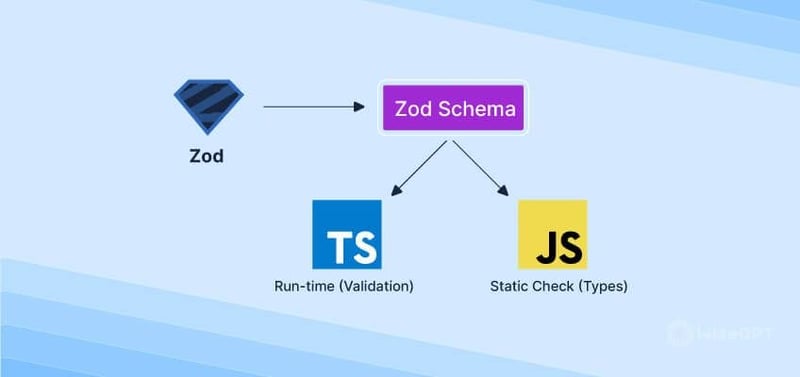
If you're using TypeScript (and if you're not, you should consider it!), Zod plays nicely with it. It can automatically infer TypeScript types from your schemas, which is a huge time-saver. While TypeScript checks types at compile-time, Zod does it at runtime. This means you can catch data issues that might slip through static type checking. You can use Zod for all sorts of data validation scenarios, from simple form inputs to complex API responses.
Project Setup
Let's start by setting up our Next.js project with all the necessary dependencies. We'll use TypeScript for type safety, Tailwind CSS for styling, Ant Design for UI components, Zod for form validation, and Resend for email functionality.
- Create a new Next.js project with TypeScript:
npx create-next-app@latest my-contact-form --typescript cd my-contact-form
- Install additional dependencies:
yarn add antd zod resend react-icons
Setup Environment variables
For sending an email, we will use Resend, so we need the Resend API key. Before starting our server, let's go to Resend and get our API keys. Click here to go to the Resend site, and click the sign-in button.

After signing in, you'll be redirected to this page. Here, you'll see all the emails you received from your form.
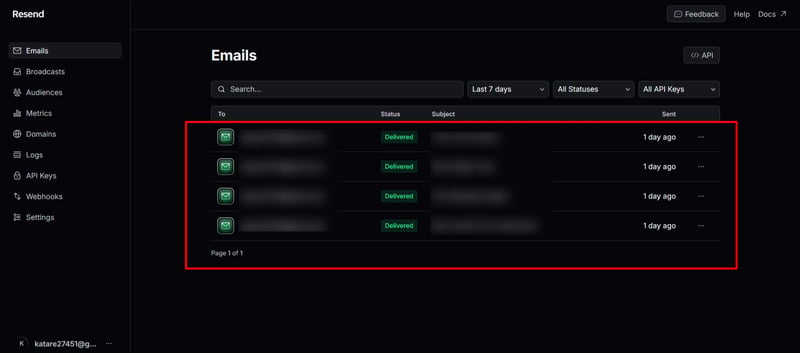
Here, click on the API Keys section
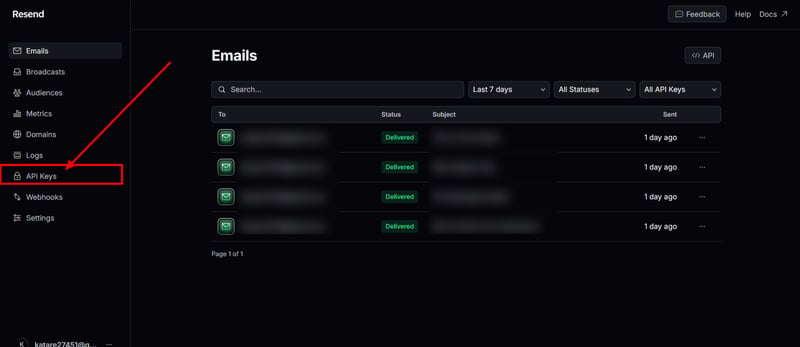
And, generate an API key by clicking on this ? button
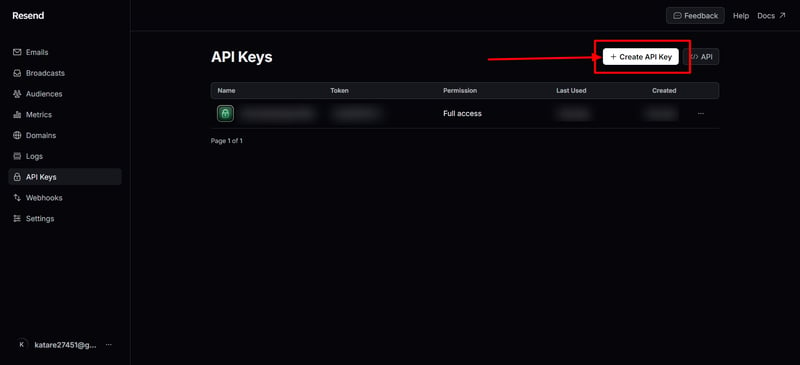
Now, copy that API key and keep it safe. Next, open VSCode and create a new file named .env in your root folder. Add an environment variable there.
RESEND_API_KEY=yourapikeywillbehere
Now you can also run your server using this command.
yarn dev
Email Template Component
Let's start by creating an email template. This will be the template you receive when someone sends you an email via the contact form.
import * as React from 'react';
interface EmailTemplateProps {
firstName: string;
message: string;
}
export const EmailTemplate: React.FC = ({
firstName,
message,
}) => (
Hello, I am {firstName}!
You have received a new message from your Portfolio:
{message}
);
This simple React component defines the structure of the email that will be sent when someone submits the contact form. It takes two props: firstName and message. The component creates a personalized greeting using the first name and displays the submitted message.
Implementing Email Sending with Resend API
Here. we'll see how to implement email-sending functionality using the Resend API.
The Code Structure
First, let's look at where this code lives in our Next.js project:
app/ ├── api/ │ └── v1/ │ └── send/ │ └── route.ts
This structure follows Next.js 13's App Router convention, where API routes are defined as route handlers within the app directory.
This is our complete API route code ?
import { EmailTemplate } from 'app/components/email-template';
import { NextResponse } from 'next/server';
import { Resend } from 'resend';
import { v4 as uuid } from 'uuid';
const resend = new Resend(process.env.RESEND_API_KEY);
export async function POST(req: Request) {
try {
const { name, email, subject, message } = await req.json();
const { data, error } = await resend.emails.send({
from: 'Contact Form ',
to: '[email protected]',
subject: subject || 'New Contact Form Submission',
reply_to: email,
headers: {
'X-Entity-Ref-ID': uuid(),
},
react: EmailTemplate({ firstName: name, message }) as React.ReactElement,
});
if (error) {
return NextResponse.json({ error }, { status: 500 });
}
return NextResponse.json({ data, message: 'success' }, { status: 200 });
} catch (error) {
console.error('Error processing request:', error);
return NextResponse.json({ error: 'Failed to process request' }, { status: 500 });
}
}
Breaking Down the Code
Now, let's examine each part of the code:
import { EmailTemplate } from 'app/components/email-template';
import { NextResponse } from 'next/server';
import { Resend } from 'resend';
import { v4 as uuid } from 'uuid';
These import statements bring in the necessary dependencies:
- EmailTemplate: A custom React component for our email content(That we already built above.
- NextResponse: Next.js utility for creating API responses.
- Resend: The Resend API client.
- uuid: For generating unique identifiers.
const resend = new Resend(process.env.RESEND_API_KEY);
Here, we initialize the Resend client with our API key. It's crucial to keep this key secret, so we store it in an environment variable.
export async function POST(req: Request) {
// ... (code inside this function)
}
This exports an async function named POST, which Next.js will automatically use to handle POST requests to this route.
const { name, email, subject, message } = await req.json();
We extract the form data from the request body. This assumes the client is sending a JSON payload with these fields.
const { data, error } = await resend.emails.send({
from: 'Contact Form ',
to: '[email protected]',
subject: subject || 'New Contact Form Submission',
reply_to: email,
headers: {
'X-Entity-Ref-ID': uuid(),
},
react: EmailTemplate({ firstName: name, message }) as React.ReactElement,
});
This is where we'll get our emails! We use Resend's send method to dispatch the email:
- from: The sender's email address.
- to: The recipient's email address.
- subject: The email subject, using the provided subject or a default.
- reply_to: Sets the reply-to address to the form submitter's email.
- headers: Includes a unique ID for tracking.
- react: Uses our custom EmailTemplate component to generate the email content.
if (error) {
return NextResponse.json({ error }, { status: 500 });
}
return NextResponse.json({ data, message: 'success' }, { status: 200 });
Here, we handle the response from Resend. If there's an error, we return a 500 status with the error details. Otherwise, we send a success response.
catch (error) {
console.error('Error processing request:', error);
return NextResponse.json({ error: 'Failed to process request' }, { status: 500 });
}
This catch block handles any unexpected errors, logs them, and returns a generic error response.
And that's it! We've set up our API route. The only thing left is to set up our logic and UI. Let's do that too ?
Contact Page Component
In your app directory, create a new folder named contact-form and inside this folder, create a file named page.tsx.
app/ ├── contact-form/ │ └── page.tsx
Imports and Dependencies
First, import all necessary components from Ant Design, Next.js, and React Icons. We also import Zod for form validation.
import React from 'react';
import { Form, Input, Button, message, Space, Divider, Typography } from 'antd';
import Head from 'next/head';
import { FaUser } from 'react-icons/fa';
import { MdMail } from 'react-icons/md';
import { FaMessage } from 'react-icons/fa6';
import { z } from 'zod';
import Paragraph from 'antd/es/typography/Paragraph';
UI Layout and Design
Now, let's create our UI, and then we'll move on to the logic. Our form will look something like this.?

In your page.tsx, after all the import statements, define a component and add a return statement first.
const ContactPage: React.FC = () => {
return (
/* our code will be here */
);
};
export default ContactPage;
Currently, we have just a simple div with a few tailwind styling now, we'll first add our heading part.
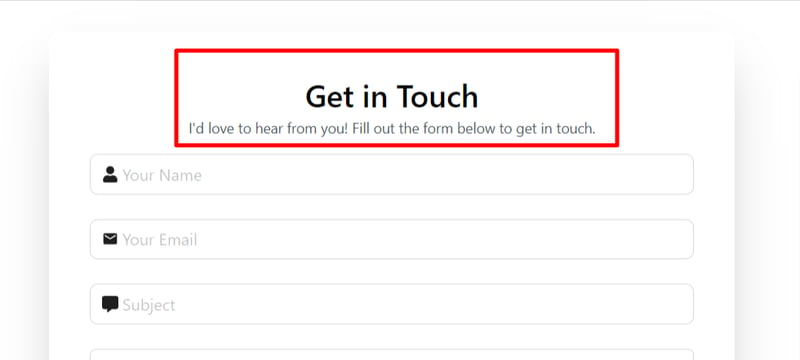
...
Get in Touch
I'd love to hear from you! Fill out the form below to get in touch.
...
Now, let's add our input fields
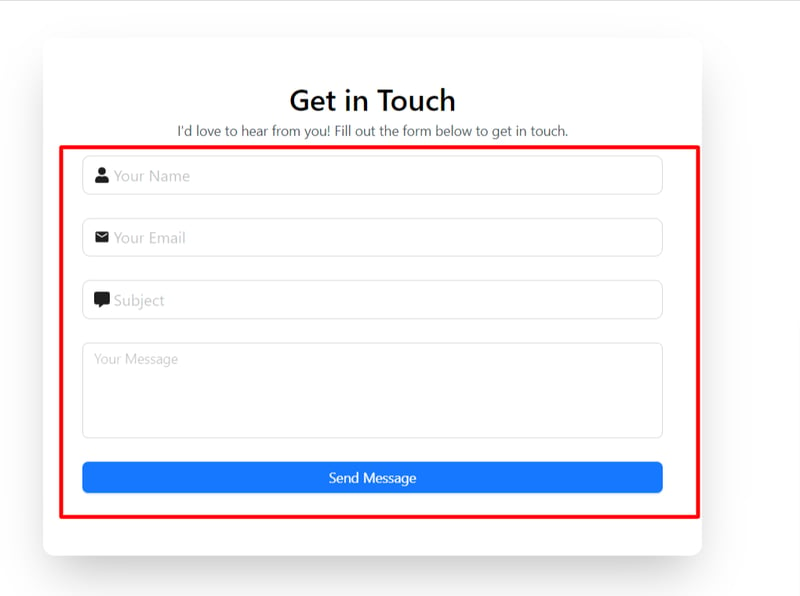
...
Here, in the above code firstly we added a Form Component. This is the main Form component from Ant Design. It has the following props:
- form: Links the form to the form object created using Form.useForm().
- name: Gives the form a name, in this case, "contact".
- onFinish(we'll declare this function in our next section): Specifies the function to be called when the form is submitted successfully.
- layout: Sets the form layout to "vertical".
- className: Applies CSS classes for styling.
Then, we added a Form Items. Each Form.Item represents a field in the form. Let's look at the "name" field as an example.
- name: Specifies the field name.
- rules: An array of validation rules. Here, it's set as required.
- The Input component is used for text input, with a user icon prefix and a placeholder.
Similarly, we have Email and other fields.
This field has an additional rule to ensure the input is a valid email address.
Subject and Message Fields: These are similar to the name field, with the message field using a TextArea component for multi-line input.
Then, we have a Submit Button to submit our form
This is the submit button for the form. It's disabled when isSubmitting (we'll add this state in our next section) is true, and its text changes to "Sending..." during submission.
Form Submission Logic
So, in the logic part, we have a few things to do:
- Setting up Zod schema for form validation
- Adding new states
- and, implementing a onFinish function
We'll start with setting up our schema first.
// Zod schema for form validation
const contactSchema = z.object({
name: z.string().min(4, 'Name must be at least 4 characters').max(50, 'Name must not exceed 50 characters'),
email: z.string().email('Invalid email address').regex(/^[\w-\.] @([\w-] \.) [\w-]{2,4}$/, "Email must be a valid format"),
subject: z.string().min(5, 'Subject must be at least 5 characters').max(100, 'Subject must not exceed 100 characters'),
message: z.string().min(20, 'Message must be at least 20 characters').max(1000, 'Message must not exceed 1000 characters'),
});
type ContactFormData = z.infer;
This part defines a Zod schema for form validation. As we already learned, Zod is a TypeScript-first schema declaration and validation library. The contactSchema object defines the structure and validation rules for the contact form:
- name: Must be a string between 4 and 50 characters.
- email: Must be a valid email address and match the specified regex pattern.
- subject: Must be a string between 5 and 100 characters.
- message: Must be a string between 20 and 1000 characters.
The ContactFormData type is inferred from the Zod schema, providing type safety for the form data.
Now, let's add 2 new states and implement our onFinish function.
const ContactPage: React.FC = () => {
const [form] = Form.useForm();
const [isSubmitting, setIsSubmitting] = React.useState(false);
const onFinish = async (values: ContactFormData) => {
setIsSubmitting(true);
try {
contactSchema.parse(values);
const response = await fetch('/api/v1/send', {
method: 'POST',
headers: {
'Content-Type': 'application/json',
},
body: JSON.stringify(values),
});
if (!response.ok) {
message.error('Failed to send message. Please try again.');
setIsSubmitting(false);
}
const data = await response.json();
if (data.message === 'success') {
message.success('Message sent successfully!');
setIsSubmitting(false);
form.resetFields();
} else {
throw new Error('Failed to send message');
}
} catch (error) {
if (error instanceof z.ZodError) {
error.errors.forEach((err) => {
message.error(err.message);
setIsSubmitting(false);
});
} else {
message.error('Failed to send message. Please try again.');
setIsSubmitting(false);
}
} finally {
setIsSubmitting(false);
}
};
This part defines the ContactPage functional component:
- It uses the Form.useForm hook to create a form instance.
- It manages a isSubmitting state to track form submission status.
- The onFinish function is called when the form is submitted:
- It sets isSubmitting to true.
- It uses contactSchema.parse(values) to validate the form data against the Zod schema.
- If validation passes, it sends a POST request to /api/v1/send with the form data.
- It handles the response, showing success or error messages accordingly.
- If there's a Zod validation error, it displays the error message.
- Finally, it sets isSubmitting back to false.
This setup ensures that the form data is validated on both the client-side (using Antd's form validation) and the server-side (using Zod schema validation) before sending the data to the server. It also manages the submission state and provides user feedback through success or error messages.
And, this is the complete code of our contact-form file ?
"use client";
import React from 'react';
import { Form, Input, Button, message, Space, Divider, Typography } from 'antd';
import Head from 'next/head';
import { FaUser } from 'react-icons/fa';
import { MdMail } from 'react-icons/md';
import { FaMessage } from 'react-icons/fa6';
import { z } from 'zod';
import { Container } from 'app/components/container';
import Paragraph from 'antd/es/typography/Paragraph';
const { TextArea } = Input;
const { Text } = Typography;
// Zod schema for form validation
const contactSchema = z.object({
name: z.string().min(4, 'Name must be at least 4 characters').max(50, 'Name must not exceed 50 characters'),
email: z.string().email('Invalid email address').regex(/^[\w-\.] @([\w-] \.) [\w-]{2,4}$/, "Email must be a valid format"),
subject: z.string().min(5, 'Subject must be at least 5 characters').max(100, 'Subject must not exceed 100 characters'),
message: z.string().min(20, 'Message must be at least 20 characters').max(1000, 'Message must not exceed 1000 characters'),
});
type ContactFormData = z.infer;
const ContactPage: React.FC = () => {
const [form] = Form.useForm();
const [isSubmitting, setIsSubmitting] = React.useState(false);
const onFinish = async (values: ContactFormData) => {
setIsSubmitting(true);
try {
contactSchema.parse(values);
const response = await fetch('/api/v1/send', {
method: 'POST',
headers: {
'Content-Type': 'application/json',
},
body: JSON.stringify(values),
});
if (!response.ok) {
message.error('Failed to send message. Please try again.');
setIsSubmitting(false);
}
const data = await response.json();
if (data.message === 'success') {
message.success('Message sent successfully!');
setIsSubmitting(false);
form.resetFields();
} else {
throw new Error('Failed to send message');
}
} catch (error) {
if (error instanceof z.ZodError) {
error.errors.forEach((err) => {
message.error(err.message);
setIsSubmitting(false);
});
} else {
message.error('Failed to send message. Please try again.');
setIsSubmitting(false);
}
} finally {
setIsSubmitting(false);
}
};
return (
Get in Touch
I'd love to hear from you! Fill out the form below to get in touch.
} placeholder="Your Name" size="large" />
} placeholder="Your Email" size="large" />
} placeholder="Subject" size="large" />
);
};
export default ContactPage;
Testing
Till now, we're all set, now it's time to run and test our application.
Start your server:
yarn dev
First, let's try to hit the endpoint without filling out the form. As expected, the API doesn't get called, and we receive error messages.
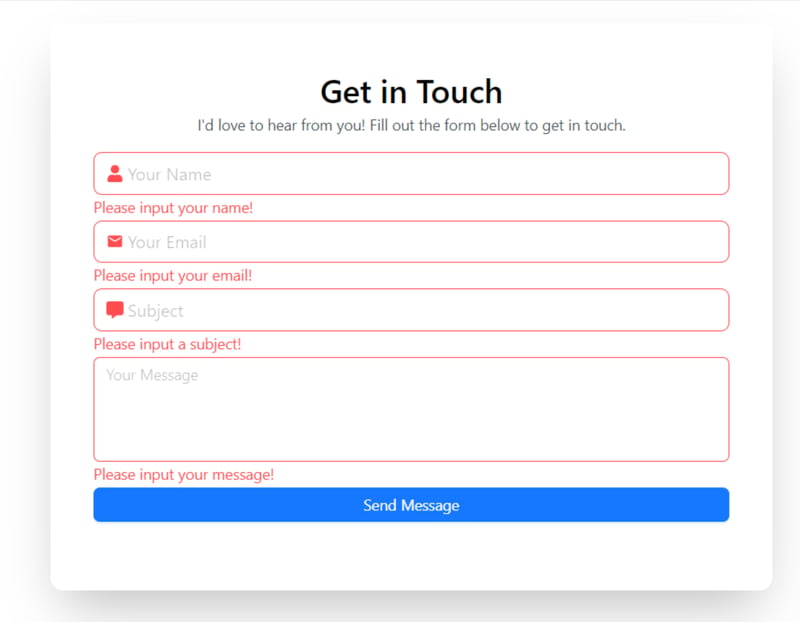
Now, let's fill out the form
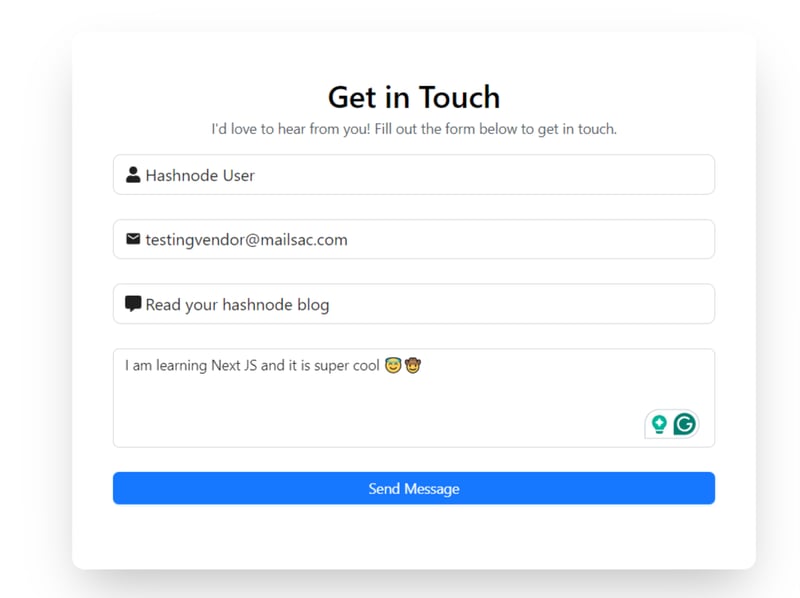
and hit the send button. It's in process.
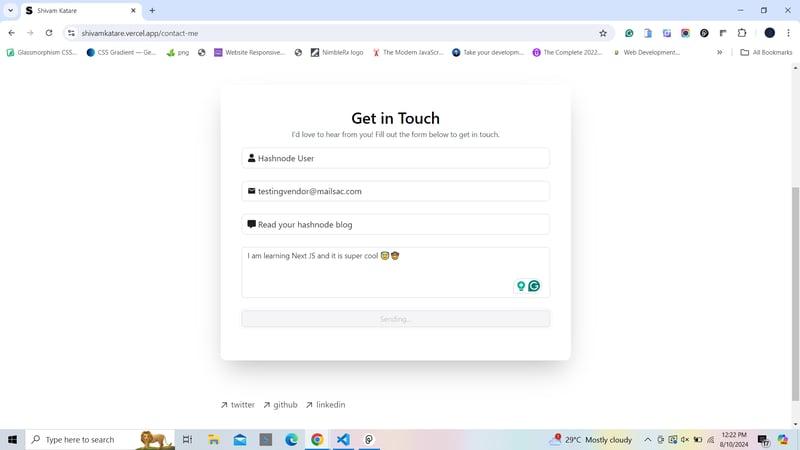
Here we go, the message is sent. The sender receives a notification saying "Message sent," and the form is also refreshed.
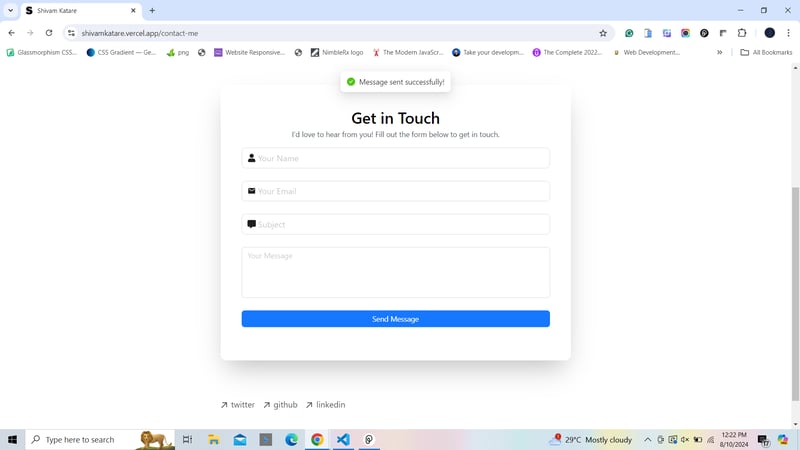
The receiver also gets the message?
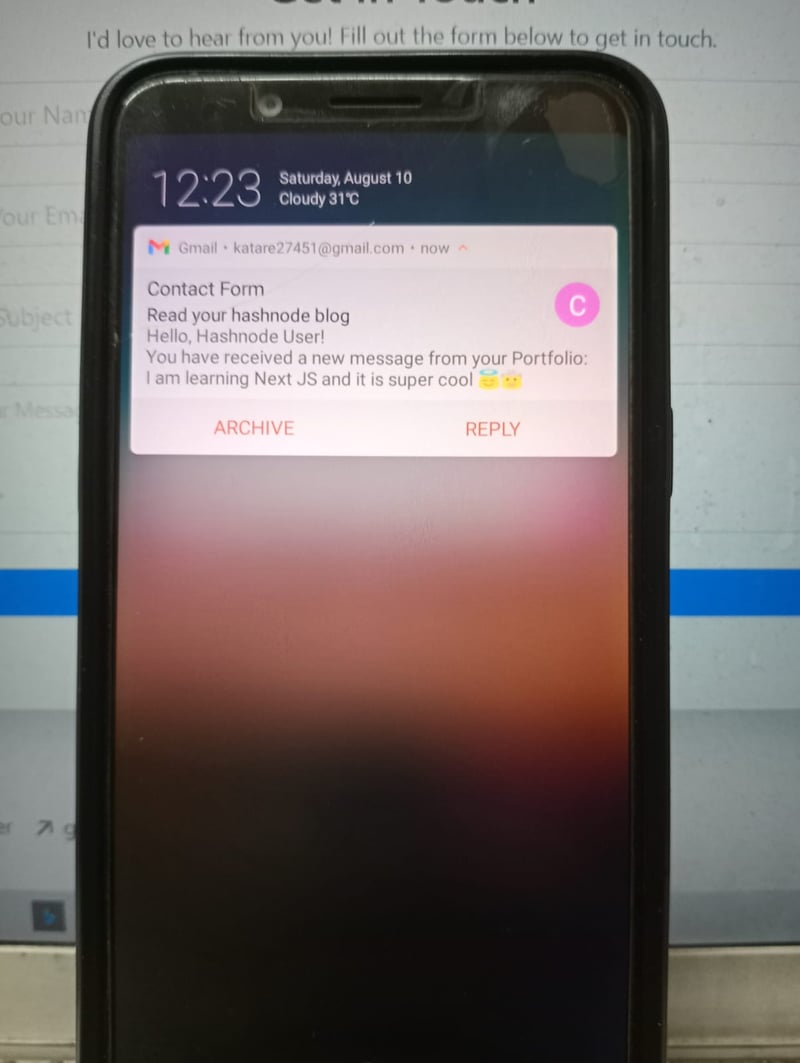
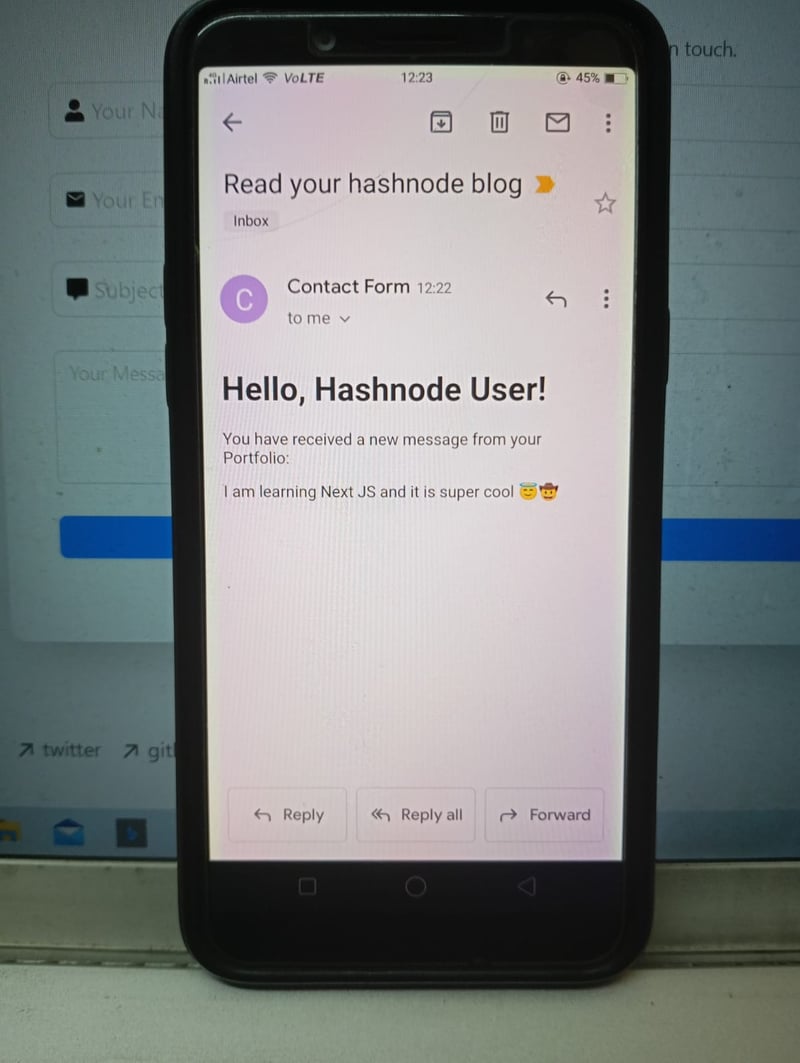
And that's it. We have successfully built an email contact form in Next.js using Resend and Zod.
Conclusion
In this article, we built a contact form using Next.js and implemented features like form validation with Zod and email functionality with Resend. We start by setting up the Next.js project, configuring necessary dependencies, and managing environment variables for secure API access.
Then, we designed the email template, set up an API route for handling email submissions, and implemented the frontend form with Ant Design components.
If you want to see a live preview of it, you can check it out here. I have implemented the same form in my portfolio.
Thanks for reading this blog. If you learned something from it, please like and share it with your friends and community. I write blogs and share content on JavaScript, TypeScript, Open Source, and other web development-related topics. Feel free to follow me on my socials. I'll see you in the next one. Thank You :)
GitHub
-
 緩衝區:Node.jsNode.js 中緩衝區的簡單指南 Node.js 中的 Buffer 用於處理原始二進位數據,這在處理流、文件或網路數據時非常有用。 如何建立緩衝區 來自字串: const buf = Buffer.from('Hello'); 分配特定大小的Buffer...程式設計 發佈於2024-11-05
緩衝區:Node.jsNode.js 中緩衝區的簡單指南 Node.js 中的 Buffer 用於處理原始二進位數據,這在處理流、文件或網路數據時非常有用。 如何建立緩衝區 來自字串: const buf = Buffer.from('Hello'); 分配特定大小的Buffer...程式設計 發佈於2024-11-05 -
 掌握 Node.js 中的版本管理作為開發者,我們經常遇到需要不同 Node.js 版本的專案。對於可能不經常參與 Node.js 專案的新手和經驗豐富的開發人員來說,這種情況都是一個陷阱:確保每個專案使用正確的 Node.js 版本。 在安裝依賴項並執行專案之前,驗證您的 Node.js 版本是否符合或至少相容專案的要求至關重要...程式設計 發佈於2024-11-05
掌握 Node.js 中的版本管理作為開發者,我們經常遇到需要不同 Node.js 版本的專案。對於可能不經常參與 Node.js 專案的新手和經驗豐富的開發人員來說,這種情況都是一個陷阱:確保每個專案使用正確的 Node.js 版本。 在安裝依賴項並執行專案之前,驗證您的 Node.js 版本是否符合或至少相容專案的要求至關重要...程式設計 發佈於2024-11-05 -
 如何在 Go 二進位檔案中嵌入 Git 修訂資訊以進行故障排除?確定Go 二進位檔案中的Git 修訂版部署程式碼時,將二進位檔案與建置它們的git 修訂版關聯起來會很有幫助排除故障的目的。然而,直接使用修訂號更新原始程式碼是不可行的,因為它會改變原始程式碼。 解決方案:利用建造標誌解決此挑戰的方法包括利用建造標誌。透過使用建置標誌在主套件中設定當前 git 修訂...程式設計 發佈於2024-11-05
如何在 Go 二進位檔案中嵌入 Git 修訂資訊以進行故障排除?確定Go 二進位檔案中的Git 修訂版部署程式碼時,將二進位檔案與建置它們的git 修訂版關聯起來會很有幫助排除故障的目的。然而,直接使用修訂號更新原始程式碼是不可行的,因為它會改變原始程式碼。 解決方案:利用建造標誌解決此挑戰的方法包括利用建造標誌。透過使用建置標誌在主套件中設定當前 git 修訂...程式設計 發佈於2024-11-05 -
 常見 HTML 標籤:視角HTML(超文本標記語言)構成了 Web 開發的基礎,是互聯網上每個網頁的結構。透過了解最常見的 HTML 標籤及其高級用途,到 2024 年,開發人員可以創建更有效率、更易於存取且更具視覺吸引力的網頁。在這篇文章中,我們將探討這些 HTML 標籤及其最高級的用例,以協助您提升 Web 開發技能。 ...程式設計 發佈於2024-11-05
常見 HTML 標籤:視角HTML(超文本標記語言)構成了 Web 開發的基礎,是互聯網上每個網頁的結構。透過了解最常見的 HTML 標籤及其高級用途,到 2024 年,開發人員可以創建更有效率、更易於存取且更具視覺吸引力的網頁。在這篇文章中,我們將探討這些 HTML 標籤及其最高級的用例,以協助您提升 Web 開發技能。 ...程式設計 發佈於2024-11-05 -
 了解 JavaScript 中的提升:綜合指南JavaScript 中的提升 提升是一種行為,其中變數和函數聲明在先前被移動(或「提升」)到其包含範圍(全域範圍或函數範圍)的頂部程式碼被執行。這意味著您可以在程式碼中實際聲明變數和函數之前使用它們。 變數提升 變數 用 var 宣告的變數被提升...程式設計 發佈於2024-11-05
了解 JavaScript 中的提升:綜合指南JavaScript 中的提升 提升是一種行為,其中變數和函數聲明在先前被移動(或「提升」)到其包含範圍(全域範圍或函數範圍)的頂部程式碼被執行。這意味著您可以在程式碼中實際聲明變數和函數之前使用它們。 變數提升 變數 用 var 宣告的變數被提升...程式設計 發佈於2024-11-05 -
 將 Stripe 整合到單一產品 Django Python 商店中In the first part of this series, we created a Django online shop with htmx. In this second part, we'll handle orders using Stripe. What We'll...程式設計 發佈於2024-11-05
將 Stripe 整合到單一產品 Django Python 商店中In the first part of this series, we created a Django online shop with htmx. In this second part, we'll handle orders using Stripe. What We'll...程式設計 發佈於2024-11-05 -
 在 Laravel 測試排隊作業的技巧使用 Laravel 應用程式時,經常會遇到命令需要執行昂貴任務的情況。為了避免阻塞主進程,您可能決定將任務卸載到可以由佇列處理的作業。 讓我們來看一個例子。想像一下指令 app:import-users 需要讀取一個大的 CSV 檔案並為每個條目建立一個使用者。該命令可能如下所示: /* Imp...程式設計 發佈於2024-11-05
在 Laravel 測試排隊作業的技巧使用 Laravel 應用程式時,經常會遇到命令需要執行昂貴任務的情況。為了避免阻塞主進程,您可能決定將任務卸載到可以由佇列處理的作業。 讓我們來看一個例子。想像一下指令 app:import-users 需要讀取一個大的 CSV 檔案並為每個條目建立一個使用者。該命令可能如下所示: /* Imp...程式設計 發佈於2024-11-05 -
 如何創建人類層級的自然語言理解 (NLU) 系統Scope: Creating an NLU system that fully understands and processes human languages in a wide range of contexts, from conversations to literature. ...程式設計 發佈於2024-11-05
如何創建人類層級的自然語言理解 (NLU) 系統Scope: Creating an NLU system that fully understands and processes human languages in a wide range of contexts, from conversations to literature. ...程式設計 發佈於2024-11-05 -
 如何使用 JSTL 迭代 HashMap 中的 ArrayList?使用JSTL 迭代HashMap 中的ArrayList在Web 開發中,JSTL(JavaServer Pages 標準標記庫)提供了一組標記來簡化JSP 中的常見任務( Java 伺服器頁面)。其中一項任務是迭代資料結構。 要迭代 HashMap 及其中包含的 ArrayList,可以使用 JS...程式設計 發佈於2024-11-05
如何使用 JSTL 迭代 HashMap 中的 ArrayList?使用JSTL 迭代HashMap 中的ArrayList在Web 開發中,JSTL(JavaServer Pages 標準標記庫)提供了一組標記來簡化JSP 中的常見任務( Java 伺服器頁面)。其中一項任務是迭代資料結構。 要迭代 HashMap 及其中包含的 ArrayList,可以使用 JS...程式設計 發佈於2024-11-05 -
 Encore.ts — 比 ElysiaJS 和 Hono 更快几个月前,我们发布了 Encore.ts — TypeScript 的开源后端框架。 由于已经有很多框架,我们想分享我们做出的一些不常见的设计决策以及它们如何带来卓越的性能数据。 性能基准 我们之前发布的基准测试显示 Encore.ts 比 Express 快 9 倍,比 Fasti...程式設計 發佈於2024-11-05
Encore.ts — 比 ElysiaJS 和 Hono 更快几个月前,我们发布了 Encore.ts — TypeScript 的开源后端框架。 由于已经有很多框架,我们想分享我们做出的一些不常见的设计决策以及它们如何带来卓越的性能数据。 性能基准 我们之前发布的基准测试显示 Encore.ts 比 Express 快 9 倍,比 Fasti...程式設計 發佈於2024-11-05 -
 為什麼使用 + 對字串文字進行字串連接失敗?連接字串文字與字串在 C 中,運算子可用於連接字串和字串文字。但是,此功能存在限制,可能會導致混亂。 在問題中,作者嘗試連接字串文字「Hello」、「,world」和「!」以兩種不同的方式。第一個例子:const string hello = "Hello"; const str...程式設計 發佈於2024-11-05
為什麼使用 + 對字串文字進行字串連接失敗?連接字串文字與字串在 C 中,運算子可用於連接字串和字串文字。但是,此功能存在限制,可能會導致混亂。 在問題中,作者嘗試連接字串文字「Hello」、「,world」和「!」以兩種不同的方式。第一個例子:const string hello = "Hello"; const str...程式設計 發佈於2024-11-05 -
 React 重新渲染:最佳效能的最佳實踐React高效率的渲染機制是其受歡迎的關鍵原因之一。然而,隨著應用程式複雜性的增加,管理元件重新渲染對於最佳化效能變得至關重要。讓我們探索優化 React 渲染行為並避免不必要的重新渲染的最佳實踐。 1. 使用 React.memo() 作為函數式元件 React.memo() 是...程式設計 發佈於2024-11-05
React 重新渲染:最佳效能的最佳實踐React高效率的渲染機制是其受歡迎的關鍵原因之一。然而,隨著應用程式複雜性的增加,管理元件重新渲染對於最佳化效能變得至關重要。讓我們探索優化 React 渲染行為並避免不必要的重新渲染的最佳實踐。 1. 使用 React.memo() 作為函數式元件 React.memo() 是...程式設計 發佈於2024-11-05 -
 如何實作條件列建立:探索 Pandas DataFrame 中的 If-Elif-Else?Creating a Conditional Column: If-Elif-Else in Pandas給定的問題要求將新列新增至DataFrame 中基於一系列條件標準。挑戰在於在實現這些條件的同時保持程式碼效率和可讀性。 使用函數應用程式的解決方案一種方法涉及創建一個將每一行映射到所需結果的函...程式設計 發佈於2024-11-05
如何實作條件列建立:探索 Pandas DataFrame 中的 If-Elif-Else?Creating a Conditional Column: If-Elif-Else in Pandas給定的問題要求將新列新增至DataFrame 中基於一系列條件標準。挑戰在於在實現這些條件的同時保持程式碼效率和可讀性。 使用函數應用程式的解決方案一種方法涉及創建一個將每一行映射到所需結果的函...程式設計 發佈於2024-11-05
學習中文
- 1 走路用中文怎麼說? 走路中文發音,走路中文學習
- 2 坐飛機用中文怎麼說? 坐飞机中文發音,坐飞机中文學習
- 3 坐火車用中文怎麼說? 坐火车中文發音,坐火车中文學習
- 4 坐車用中文怎麼說? 坐车中文發音,坐车中文學習
- 5 開車用中文怎麼說? 开车中文發音,开车中文學習
- 6 游泳用中文怎麼說? 游泳中文發音,游泳中文學習
- 7 騎自行車用中文怎麼說? 骑自行车中文發音,骑自行车中文學習
- 8 你好用中文怎麼說? 你好中文發音,你好中文學習
- 9 謝謝用中文怎麼說? 谢谢中文發音,谢谢中文學習
- 10 How to say goodbye in Chinese? 再见Chinese pronunciation, 再见Chinese learning

























